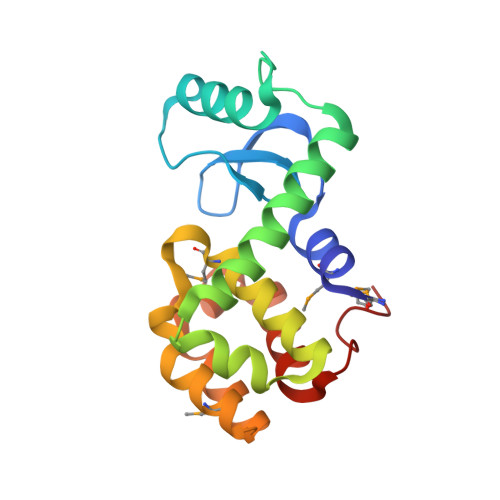Use of experimental crystallographic phases to examine the hydration of polar and nonpolar cavities in T4 lysozyme
Liu, L., Quillin, M.L., Matthews, B.W.(2008) Proc Natl Acad Sci U S A 105: 14406-14411
- PubMed: 18780783
- DOI: https://doi.org/10.1073/pnas.0806307105
- Primary Citation of Related Structures:
3DKE - PubMed Abstract:
There is conflicting evidence as to whether cavities in proteins that are nonpolar and large enough to accommodate solvent are empty or are occupied by disordered water molecules. Here, we use multiple-wavelength x-ray data collected from crystals of the selenomethionine-substituted L99A/M102L mutant of T4 lysozyme to obtain a high-resolution electron density map free of bias that is unavoidably associated with conventional model-based structure determination and refinement. The mutant, L99A/M102L, has four cavities, two being polar in character and the other two nonpolar. Cavity 1 (polar, volume 45.2 A(3)) was expected to contain two well ordered water molecules, and this is confirmed in the experimental electron density map. Likewise, cavity 2 (polar, 16.9 A(3)) is confirmed to contain a single water molecule. Cavity 3 (nonpolar, 21.4 A(3)) was seen to be empty in conventional x-ray refinement, and this is confirmed in the experimental map. Unexpectedly, however, cavity 4 (nonpolar, volume 133.5 A(3)) was seen to contain diffuse electron density equivalent to approximately 1.5 water molecules. Although cavity 4 is largely nonpolar, it does have some polar character, and this apparently contributes to the presence of solvent. The cavity is large enough to accommodate four to five water molecules, and it appears that a hydrogen-bonded chain of three or more solvent molecules could occupy the cavity at a given time. The results are consistent with theoretical predictions that cavities in proteins that are strictly nonpolar will not contain solvent until the volume is large enough to permit mutually satisfying water-water hydrogen bonds.
- Institute of Molecular Biology, Department of Physics, University of Oregon, Eugene, OR 97403-1229, USA.
Organizational Affiliation:
























